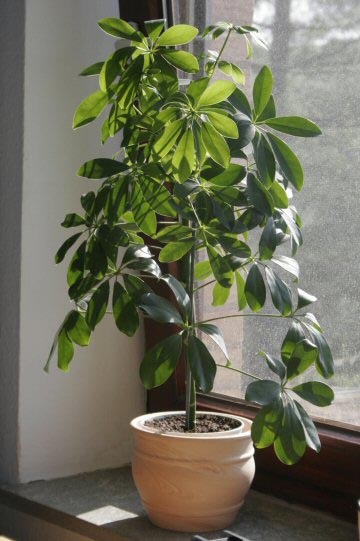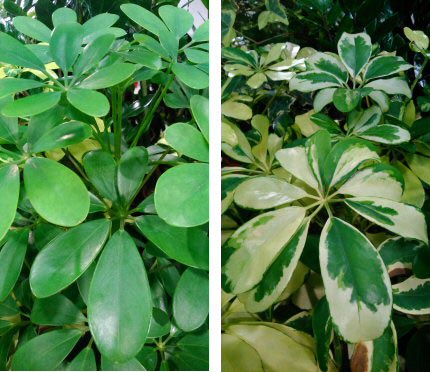





The Umbrella Plant (Schefflera or Heptapleurum) is another houseplant which goes by many names including the Dwarf Umbrella Tree, Parasol Plant and Octopus Tree.  It's not to be confused with Cyperus which is another type of Umbrella Plant altogether. However Schefflera does have very strong links to Heptapleurum, so much so the two plants are incredibly difficult to tell apart. The care instructions can be applied to both houseplants and there isn't a great deal of difference so the names tend to be used interchangeably.
It's not to be confused with Cyperus which is another type of Umbrella Plant altogether. However Schefflera does have very strong links to Heptapleurum, so much so the two plants are incredibly difficult to tell apart. The care instructions can be applied to both houseplants and there isn't a great deal of difference so the names tend to be used interchangeably.
An Umbrella Plant in your home or place of work should be very easy for you to take care of, in addition it will help you out by cleaning the air for you. They are normally undemanding and providing, as the bare minimum, you water at least a few times each month you can have a beautiful looking plant to brighten up and give structure to a dull corner or used more boldly by having it flank a doorway. The versatility continues because you can choose to have it as a tall and slender specimen placed at floor level and reaching for the ceiling, or keep it compact and short on the coffee table, it can suit many positions and will adapt to a variety of conditions.
The main downside is with age, or prolonged incorrect care, the lower leaves will fall and you will have a bare lower stem but still with a full canopy, which despite sometimes being called an Umbrella Tree, can look very odd indoors. The plant also offers very low resistance to pests, with Red Spider Mite and Scale Insects being a possible serious problem.  All problems can however be overcome, so if you'd like an Umbrella Plant as a house guest get out there and get one.
All problems can however be overcome, so if you'd like an Umbrella Plant as a house guest get out there and get one.
There are several different varieties and growth habits to pick from. Firstly you need to decide if you want an all green variety or an Umbrella Plant with variegated leaves. The green ones although arguably less attractive are much better suited to coping with less light and lower temperatures, where the variegation varieties are less tolerant of such conditions and have a shorter height. You do need to think about the ultimate placement in your home first, but other than that pick your favorite.
S. actinophylla tends to have much more all green varieties and even when there is variegation it's slight and subtle, where as S. arboricola is the name you want to be searching for if you want variegation. This species tends to be more common these days so you will probably come across the variegated types much more frequently in shops. There are several varieties which are particular highlights and worth looking for, which includes "Gold Capella", "Green Gold" and "Compacta".
Light
Choose a position that offers good light without direct sunlight if you want the best results, in time this will result in a neat bushy plant that can become tall and "tree" like. However Schefflera is an accommodating plant for the most part so even if you choose a slightly darker home for it, things should still work out. Although it will grow slower and potentially have more of a leggy appearance as the leaves will be spaced out more. Some direct sunlight is acceptable but more than a few hours a day will cause scorch damage to the leaves.
Watering
The Umbrella Plant loves to be growing in moist soil for really good growth to occur, but it will certainly accept a level of underwatering, so if you forget to water it for a week or two after the soil last dried out, it should forgive you. It's not so forgiving of being overwatered however which can result in root and stem rot. Pour any excess water collected in the drip tray away to avoid this problem. In general the bigger the plant the more water it's going to need except when it becomes inactive in Winter, at which point just water enough to keep it ticking over.
Umbrella Plants are very popular with Insects - High humidity levels can help you keep them at bay
Humidity
Many modern houseplants aren't usually too fussed about humidity, or rather the typically humidity levels you would expect in a home or office. However these plants are very popular with insects like Red Spider Mite and Scale, so if you keep having problems with these bugs you might want to look at findings ways to make the atmosphere more humid to deter them permanently.
Feeding
Umbrella Plants can put out a lot of leaf and stem growth over a growing season so they do need regular feeding to fuel and sustain that level of growth. Use a general fertiliser at normal strength every couple of weeks, follow the manufacturer's instructions. Stop feeding when the temperature drops or whenever the plant becomes inactive i.e. when it reaches its ultimate (or desired) height.
Temperature
Scheffleras like an all round temperature range between 15°C / 59°F to 21°C / 70°F. The all green variety tends to be happier at the lower end of the scale where as the variegated types prefer the upper temperature levels. If things get too cold, leaves will fall off.
Copyright © www.100flowers.win Botanic Garden All Rights Reserved